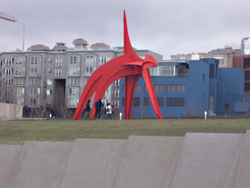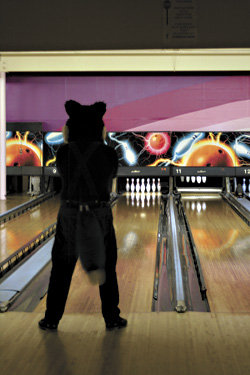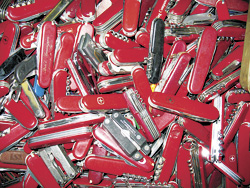Art critics may be still weighing the pluses and minuses of the new Olympic Sculpture Park, which officially opens to the public this weekend. (See our Sue Peters’ assessment on p. 37.) But another group is already proclaiming its success: condo owners.
Dave Remer, for instance, bought a $1.8 million condominium in the Concord building when it went up on First Avenue and Eagle Street three years ago, knowing that he would soon have what he calls “the biggest backyard in the world.” Remer’s balcony overlooks the park, an 8.5-acre expanse that yields breathtaking views of the shimmering Sound and the snow-capped Olympics.
Apart from the occasional intrusion of a sculpture, that vista is now permanently open for Remer and his fellow west-facing condo owners to enjoy. “We have an unembellished aesthetic in our backyard, with an unobstructed view in perpetuity,” says Remer, a 60-year-old marketing/advertising exec who’s pursuing a degree in art history. “It’s such a great piece of our lifestyle.”
Indeed, the Seattle Art Museum likes to take at least partial credit for the profusion of upscale residential towers like the Concord that have sprung up in this formerly sleepy part of Belltown in the decade since the sculpture plan was announced, and which now ring the park like an eager, neck-craning audience.
“That’s not to say it wasn’t going to happen,” said park director Chris Rogers last Wednesday during a press tour, as he gestured toward the Concord, the Avalon, the Olympus, etc. “But [the park] helped.”
That wave of redevelopment has only gone so far, however. The choicest parkside real estate remains stubbornly occupied by a pair of low-slung, increasingly-out-of-character holdouts.
Squatting among the high-rises (and occasionally prompting complaints by their residents), Bavarian Meat Products quietly perfumes the neighborhood, like an odoriferous toadstool in a forest of giant redwoods. A family-owned business, it has occupied the site since 1974.
Across Eagle Street from that, and also abutting the park, is an unmarked, hulking blue compound bristling with surveillance cameras. Its windows are blacked out, and its only signs instruct passers-by not to loiter or trespass. This is the downtown branch of the Washington National Primate Research Center, affiliated with the University of Washington, where scientists perform experiments on monkeys.
“It’s very odd,” says Alan Winningham, a local developer who’s building the mixed-use Lumen project nearby. “You look down there, and you think, this park is going to be a huge, international, world-class addition to the city of Seattle. And are the parcels adjacent to it going to be redeveloped?”
According to the parties involved: No.
Lynn Stewart gets up well before dawn to drive to Bavarian Meats, which she co-owns with her sister. Stewart and her forebears have been grinding meat in Seattle since 1961, supplying mom-and-pop delis, QFC, and their own retail shop in Pike Place Market with headcheese (a jellied sausage made from pig’s head, feet, and tongue), fresh liver rings, and Bavarian loaf, a meat log made with pork and veal. Most of their sales are in the Puget Sound region.
Who’s their target market? Stewart says perhaps the greatest Bavarian-food fanciers are military personnel and their spouses who once were stationed on German bases. They’ll call and say, “‘Ve are out of bockwurst down here at Fort Lewis commissary. Vhat is going on?'” says Stewart. “It’s not your average hot dog.”
Stewart, a very young-looking 35, used to be a para-legal but decided it wasn’t as fun as slinging sausage. She can recite the process by rote: Meat goes from the boner to the grinder to the stuffing bin to the smokehouse, after which Stewart helps inventory and ship it. The operation hasn’t changed much over the decades. Men and women manhandle chilly meat slabs into shiny German machinery or drown legions of bratwursts in vats of boiling water. The continuous incineration of alderwood sawdust has left a rusty red coating on the ceiling.
There are, however, periodic disturb-ances in the process caused by Belltown’s boom. Condo dwellers behind the factory, for instance, drop by to complain about the fumes.
“Many mornings I’ve walked to my car in the garage and it smells like beef jerky,” says Winningham, who lives in the Concord, where the odor has been a subject of recurring complaints at board meetings, though Winningham insists he does not find it unpleasant. (The Puget Sound Clean Air Agency has done regular inspections of the business and found no air-quality violations, says agency spokesperson Alice Collingwood.)
“We’ve had people come in here and say, ‘Are you guys planning on moving? Because I’m going to buy a condo back there,'” says Stewart.
Stewart says she has no desire to move or build something different on the property, which her family owns. She can’t say for sure if anyone has offered to buy the family out, because she and her family members throw away faxes or mail that look as if they might have come from a developer. “We’re not moving, so why read it?” she says.
County records give the property an appraised land value of nearly $1.2 million. Though the site’s perhaps too small for a big Belltown-style condo development, it could be ideal for a petite pile of high-priced units. “Is there demand in that neighborhood? Absolutely,” says developer Winningham, who thinks Bavarian Meats will eventually sell out to one home builder or another. “I’d certainly consider it.”
For the UW scientists, whose research focuses on developing AIDs vaccines using monkeys, the unveiling of the city’s newest tourist amenity coincides with their own renovation plan. The center is hoping to upgrade to Animal Biosafety Level 3, so that it can infect monkeys with more virulent microorganisms.
The center is now at a biosafety level of “2 plus,” according to center director David Anderson. With the kick up to Level 3, the researchers could be infecting animals with pathogens that have a higher risk of human transmission and pack more wallop, such as tularemia or rabbit fever, which is considered a possible bioterrorism agent and can be spread through the air.
One might think that the invasion of world-renowned sculpture would be inconvenient for an animal- testing facility that tries, through lack of signage, to remain invisible to the general public and animal-rights extremists. (Ecoterrorists set the University of Washington’s Center for Urban Horticulture ablaze in 2001, and researchers with the primate center have had protesters show up at their homes.) The park’s previous incarnation—by all accounts a fallow, oil-soaked field stalked by perverts and reprobates—was perhaps an ideal neighbor.
But Anderson isn’t perturbed by the encroaching international art spotlight and influx of tourists. “We have a very secure building,” he says. “With the way some of the animal activists have approached this, we keep a tight lid on it.”
Bavarian Meats itself has endured some graffiti and the odd break-in, but so far no picketing or firebombing. Most days, the streets are quiet. It’s a perfect environment to contemplate the sculpture across the street.
Or not.
“I’m sure [the art] means a lot to somebody,” says Anderson, who considers the Bunyanesque typewriter eraser by Claes Oldenburg and Coosje van Bruggen to be a riot. “We were joking around when it first went up: ‘If we put up this huge, 20-foot bottle of ink or some other type of office supply, would that mean we’re artists?'”
“I don’t not like it,” says Stewart. “I don’t turn around and stare out the window. I’m working.”








